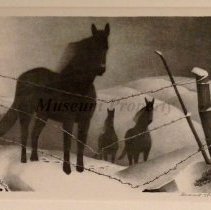Object Record
Images

Metadata
Object Name |
Lithograph |
Source |
Waterloo Center for the Arts |
Iowa History Era Tag |
World War II to an Urban State (1940-1963) |
Chronological Tag |
The Great Depression and World War II (1929-1945) |
Catalog Number |
2019.001.018 |
Description |
This is a lithograph created by Grant Wood. The lithograph depicts three black horses standing near the corner of a snow covered rolling pasture. One horse is shown larger by a barbed wire fence. Down the slope a shortways the two other horses stand. The wind is blowing the manes of the horses. This piece was commissioned in 1940 by Grant Wood. His inspiration most likely came from the wintery farm landscape of February in Iowa. Grant Wood was born in Anamosa, Iowa. He was a very well known artist and a teacher at the University of Iowa. Grant Wood's most famous painting was the iconic "American Gothic" (uima.uiowa.edu). He was part of the American Regionalism Art Movement which depicted realistic small town scenes in art (oxfordreference.com) For any use other than instructional resources, please check with the organization that owns this item regarding copyright restrictions. |
Additional Research & Sources |
Summary Resources and Additional Information for Object: Resource and Additional Information: Click Here Resource and Additional Information: Click Here This object connects with the following standards: Standard SS.3.28 Cultural Contributions: A lesson on Iowa's art culture could be created. Standard SS-US.9-12.2 Iowans Influence US History and Standard SS-WH.9-12.26 Iowans Influence World History: A lesson could be created on Grant Wood's influence on art in both America and the rest of the world. |
Primary/Secondary Source |
General primary source |
County Tag |
Jones |
People |
Wood, Grant |
Relation |
Show Related Records... |
Multimedia Links |
Click here to view/hear the file. |
Artist |
Wood, Grant |
Search Terms |
Art Art objects Artists Arts & Culture Grant Wood |
Legal Status |
Ownership of this resource is held by the Waterloo Center for the Arts and has been provided here for educational purposes only, specifically for use in the Iowa Museum Association's "Teaching Iowa History" project. It may not be downloaded, reproduced or distributed in any format without written permission from the Rights Holder. For information on U.S. and International copyright laws, consult an attorney. |
